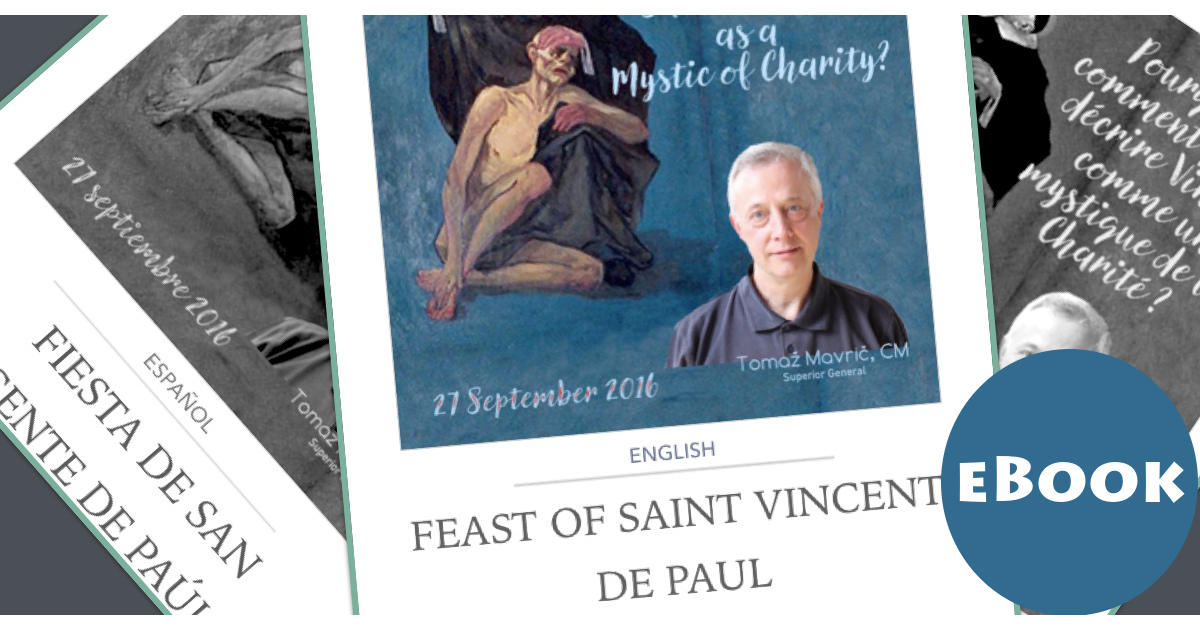In his letter to the Vincentian Family for St. Vincent’s Feast, successor to St. Vincent Fr. Tomaž Mavrič, C.M., invited three Vincentians to explore three different views — three takes — on the idea of Vincent as a “mystic of charity.” Fr. Mavrič and .famvin have explored this theme before. It’s worth looking at the three one at a time. We’ll do that today and tomorrow. Don’t have the letter at hand? Click here for lots of versions, or click the image that follows for the recently published multi-language eBook. Got it? Okay, let’s go. First, Father Hugh O’Donnell, C.M.
O’Donnell says:
We all know Vincent was a man of action, so we may be surprised to hear him also referred to as a mystic. But in fact it was his mystical experience of the Trinity and in particular the Incarnation that was the font of all his actions in favor of poor people. Henri Brémond, the distinguished historian of French spirituality, was the first to bring it to our attention. He said, “…it is (Vincent’s) mysticism which gave us the greatest of the men of action.” André Dodin and José María Ibañez later called Vincent a “mystic of action” and Giuseppe Toscani, CM, united mysticism and action and came to the heart of the matter in calling him “a mystic of Charity.” Vincent lived in a century of mystics, but he stood out as the Mystic of Charity.
Being a mystic implies experience, the experience of Mystery. For Vincent it meant a deep experience of the Mystery of God’s Love. We know that the Mysteries of the Trinity and the Incarnation were at the heart of his life. The experience of the Trinity’s inclusive love of the world and the Incarnate Word’s unconditional embrace of every human person shaped, conditioned, and fired his love of the world and everyone in it, in particular, sisters and brothers in need. He looked upon the world with the eyes of Abba and Jesus and embraced everyone with the unconditional love, warmth and energy of the Holy Spirit.
Vincent’s mysticism was the source of his apostolic action. The Mystery of God’s love and the Mystery of the Poor were the two poles of Vincent’s dynamic love. But Vincent’s Way had a third dimension, which was how he regarded time. Time was the medium through which the Providence of God made itself known to him. He acted according to God’s time, not his own. “Do the good that presents itself to be done,” he advised. “Do not tread on the heels of Providence.”
Another aspect of time for Vincent was the presence of God here and now – “God is here!” (influence of Ruysbroek). God is here in time. God is here in persons, in events, in circumstances, in poor people. God speaks to us now in and through them. Vincent was a man of unfolding history in the deepest sense. He followed the lead of Providence step by step. He had neither an ego-agenda nor an ideology. It took him decades to arrive at such interior freedom, which is why Vincent’s journey to holiness and freedom (1600-1625) is the key to understanding the daily dynamic of the Apostle of Charity.
Reflection and challenge:
You can reflect on these questions to explore this first of three takes on our mystic of charity:
1. Are you living a “deep experience of God’s love”? 2. Do you “push too hard” to achieve laudable goals, or are you content to act “according to God’s time”?
 Pray and reflect. Tomorrow, we’ll look at the second contribution to this special emphasis of Fr. Tomaž Mavrič.
Pray and reflect. Tomorrow, we’ll look at the second contribution to this special emphasis of Fr. Tomaž Mavrič.








0 Comments